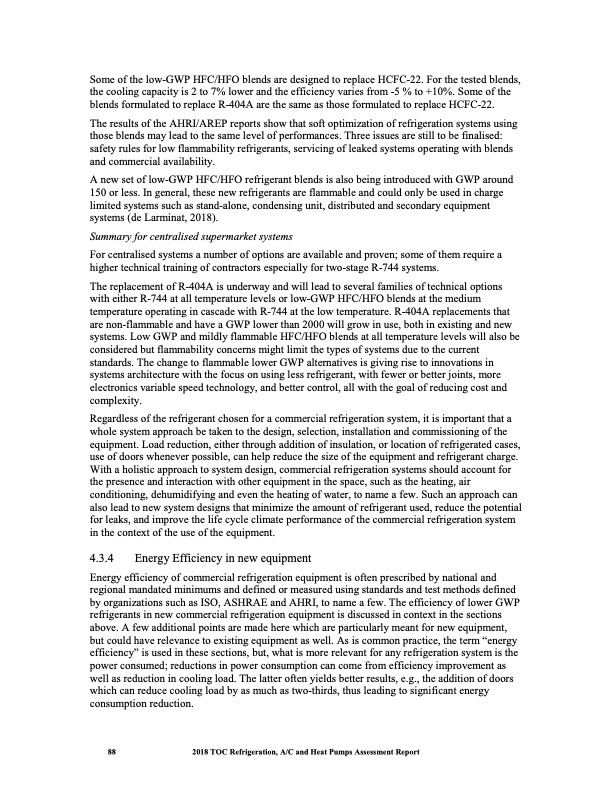
PDF Publication Title:
Text from PDF Page: 101
Some of the low-GWP HFC/HFO blends are designed to replace HCFC-22. For the tested blends, the cooling capacity is 2 to 7% lower and the efficiency varies from -5 % to +10%. Some of the blends formulated to replace R-404A are the same as those formulated to replace HCFC-22. The results of the AHRI/AREP reports show that soft optimization of refrigeration systems using those blends may lead to the same level of performances. Three issues are still to be finalised: safety rules for low flammability refrigerants, servicing of leaked systems operating with blends and commercial availability. A new set of low-GWP HFC/HFO refrigerant blends is also being introduced with GWP around 150 or less. In general, these new refrigerants are flammable and could only be used in charge limited systems such as stand-alone, condensing unit, distributed and secondary equipment systems (de Larminat, 2018). Summary for centralised supermarket systems For centralised systems a number of options are available and proven; some of them require a higher technical training of contractors especially for two-stage R-744 systems. The replacement of R-404A is underway and will lead to several families of technical options with either R-744 at all temperature levels or low-GWP HFC/HFO blends at the medium temperature operating in cascade with R-744 at the low temperature. R-404A replacements that are non-flammable and have a GWP lower than 2000 will grow in use, both in existing and new systems. Low GWP and mildly flammable HFC/HFO blends at all temperature levels will also be considered but flammability concerns might limit the types of systems due to the current standards. The change to flammable lower GWP alternatives is giving rise to innovations in systems architecture with the focus on using less refrigerant, with fewer or better joints, more electronics variable speed technology, and better control, all with the goal of reducing cost and complexity. Regardless of the refrigerant chosen for a commercial refrigeration system, it is important that a whole system approach be taken to the design, selection, installation and commissioning of the equipment. Load reduction, either through addition of insulation, or location of refrigerated cases, use of doors whenever possible, can help reduce the size of the equipment and refrigerant charge. With a holistic approach to system design, commercial refrigeration systems should account for the presence and interaction with other equipment in the space, such as the heating, air conditioning, dehumidifying and even the heating of water, to name a few. Such an approach can also lead to new system designs that minimize the amount of refrigerant used, reduce the potential for leaks, and improve the life cycle climate performance of the commercial refrigeration system in the context of the use of the equipment. 4.3.4 Energy Efficiency in new equipment Energy efficiency of commercial refrigeration equipment is often prescribed by national and regional mandated minimums and defined or measured using standards and test methods defined by organizations such as ISO, ASHRAE and AHRI, to name a few. The efficiency of lower GWP refrigerants in new commercial refrigeration equipment is discussed in context in the sections above. A few additional points are made here which are particularly meant for new equipment, but could have relevance to existing equipment as well. As is common practice, the term “energy efficiency” is used in these sections, but, what is more relevant for any refrigeration system is the power consumed; reductions in power consumption can come from efficiency improvement as well as reduction in cooling load. The latter often yields better results, e.g., the addition of doors which can reduce cooling load by as much as two-thirds, thus leading to significant energy consumption reduction. 88 2018 TOC Refrigeration, A/C and Heat Pumps Assessment ReportPDF Image | Heat Pumps Technical Options

PDF Search Title:
Heat Pumps Technical OptionsOriginal File Name Searched:
RTOC-assessment-report-2018_0.pdfDIY PDF Search: Google It | Yahoo | Bing
CO2 Organic Rankine Cycle Experimenter Platform The supercritical CO2 phase change system is both a heat pump and organic rankine cycle which can be used for those purposes and as a supercritical extractor for advanced subcritical and supercritical extraction technology. Uses include producing nanoparticles, precious metal CO2 extraction, lithium battery recycling, and other applications... More Info
Heat Pumps CO2 ORC Heat Pump System Platform More Info
| CONTACT TEL: 608-238-6001 Email: greg@infinityturbine.com | RSS | AMP |